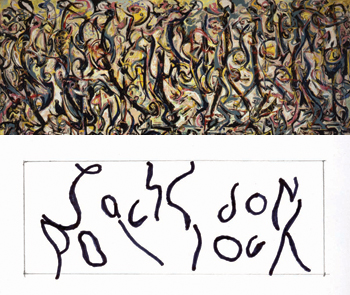Just before Jackson Pollock entered his intense “drip period,” he painted his famous Mural, 1943-44, which resides in the University of Iowa Museum of Art. But did he “sign” it, hiding his name among his paint strokes?
That is a contention of a forthcoming book, Tom and Jack by Henry Adams, which chronicles the relationship between Pollock and his teacher, Thomas Hart Benson.
If true — and not everyone agrees — it would add yet more evidence of Pollock’s self-regard, according to a new article published in the October issue of ARTNews:
That Pollock would insert his signature into the painting makes sense in terms of Mural‘s meaning for Pollock, argues Adams, a professor of American art at Case Western Reserve University in Cleveland: “The whole point of Mural was to declare that Jackson Pollock was a great painter,” he writes in Tom and Jack, which is being published in December by Bloomsbury Press. “The painting is essentially a big billboard for Jackson Pollock.”
You be the judge:

This is, of course, the very same painting that the University of Iowa proposed to sell last year, to pay for flood damage. It has been valued at $140 million.
The book, though, is not just about this painting. Rather, it “disputes the long-held assumption that Pollock rejected all of Benton’s teachings before making his major works.”
According to the article:
Adams partly relies on the work of Stephen Polcari, who noticed 30 years ago that the compositions of Pollock’s major drip paintings correspond with the recommendations Benton laid out in a series of articles in Arts magazine in 1927. But Adams adds a new angle, stressing Benton’s modernist bona fides: he was influenced, Adams writes, by a group of American modernists called the Synchromists, who combined the formal language of Cubism with the vivid colors of Matisse, arranged according to an arcane theory of color harmonization.
Adams also wrote Eakins Revealed, which relates that Eakins molested his niece, earning him Adams some emnity in the art world.
Photo Credit: ©2009 POLLOCK-KRASNER FOUNDATION/ARTISTS RIGHTS SOCIETY (ARS), NEW YORK/UNIVERSITY OF IOWA MUSEUM OF ART, GIFT OF PEGGY GUGGENHEIM 1959.6, Courtesy ARTNews
